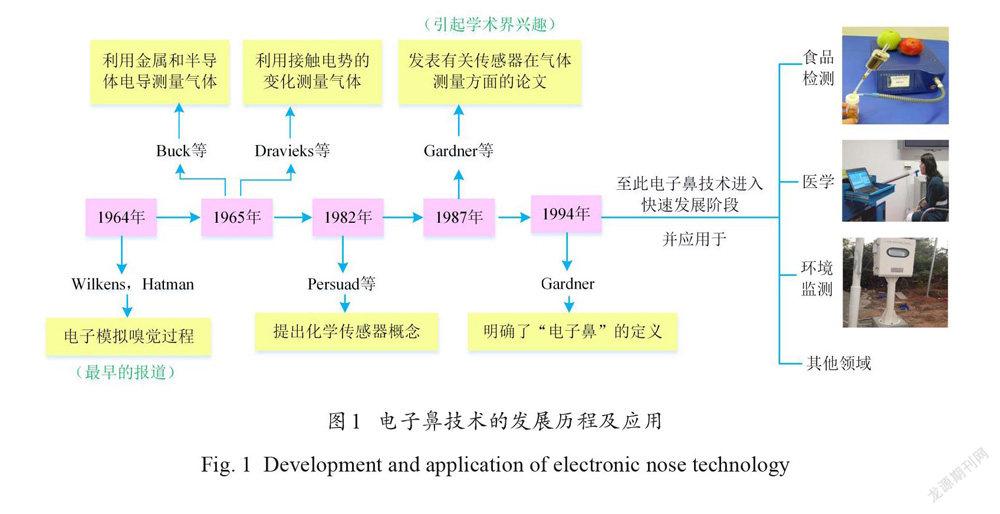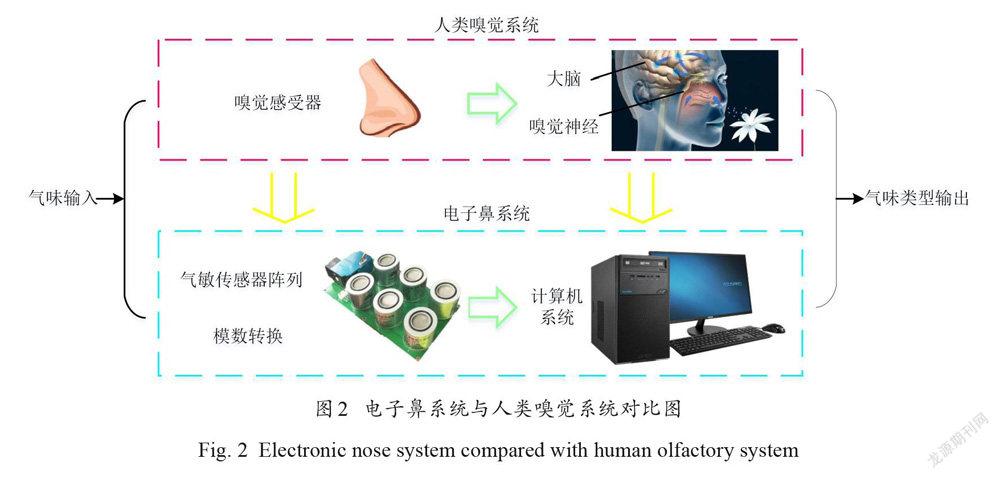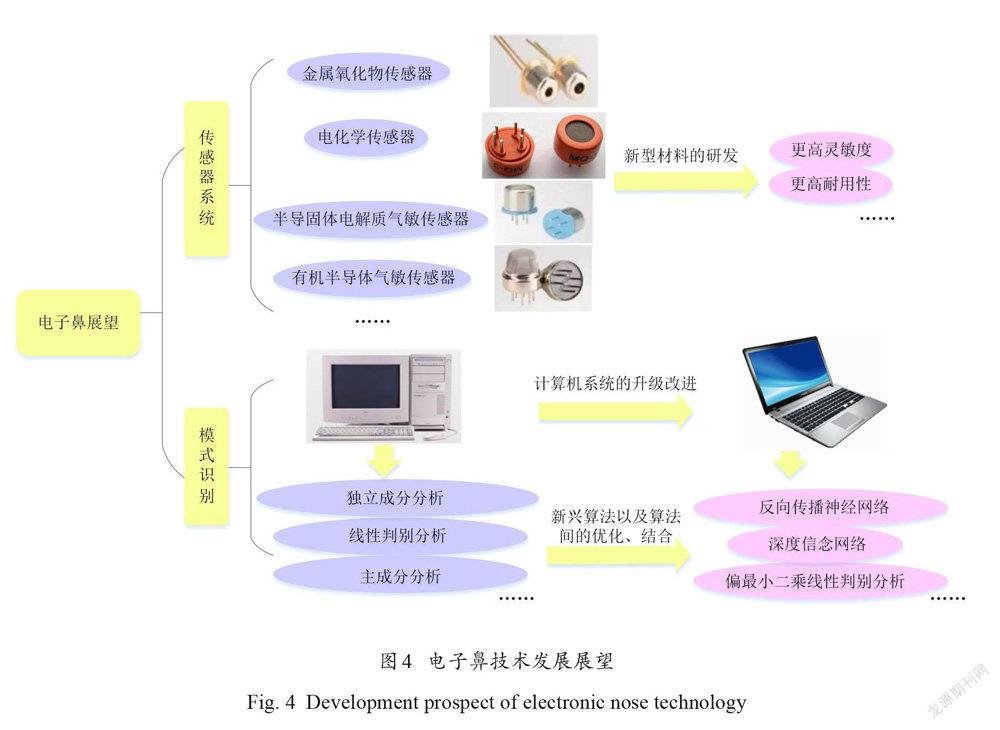电子鼻技术在肉与肉制品检测中的研究进展和应用展望
2021-03-29刘洋贾文珅马洁梁刚汪慧华周巍
刘洋 贾文珅 马洁 梁刚 汪慧华 周巍




摘要:电子鼻因具备操作简单、能够快速、无损检测的特点,满足人们对肉与肉制品安全指标高效和高精确度检测提出了更高的要求。本文阐述了电子鼻技术的检测原理和其在硬件和软件系统方面的发展;从肉与肉制品的新鲜度检测、掺假检测、风味评价、病原微生物污染检测四个方向,对近年来电子鼻技术在肉与肉制品检测的应用研究进展进行了分析,突出了电子鼻技术应用的可行性和先进性;指出电子鼻技术在肉与肉制品检测中面临的检测效果参差不齐,电子鼻仪器体积大、价格高昂,模型通用性和普及性不够等不足。最后,本文从硬件系统和软件系统两方面,对未来电子鼻技术的发展及其应用前景进行了展望,包括硬件系统方面提高电子鼻传感器阵列电极膜材料的性能,增强电子鼻耐用性和识别气味的灵敏度;软件系统方面不断探索引入新的模式识别算法,使电子鼻技术实现对气味更快、更准确的识别分析。
关键词:电子鼻;肉与肉制品;高效检测;质量安全;模式识别
中图分类号: TS207.3;TP29;TP212.9文献标志码: A文章编号:202011-SA003
引用格式:刘洋, 贾文珅, 马洁, 梁刚, 汪慧华, 周巍. 电子鼻技术在肉与肉制品检测中的研究进展和应用展望[J].智慧农业(中英文), 2021, 3(4):29-41.
LIU Yang, JIA Wenshen, MA Jie, LIANG Gang, WANG Huihua, ZHOU Wei. Research progress and application prospect of electronic nose technology in the detection of meat and meat products[J]. Smart Agriculture, 2021, 3(4):29-41.(in Chinese with English abstract)
1 引言
肉与肉制品作为人类获取蛋白质、维生素和矿物质等营养成分的重要来源,在人类生活中已不可或缺[1,2],其安全问题也逐渐成为人们关注的焦点,安全性檢测已成为至关重要的、关系民生的工程[3-5]。
食品感官检测是历史最悠久、也是最常见的传统食品检测方法[6]。官方兽医通常通过对宰杀动物时的刀口状态、肉的放血程度、血液沉积状态、肉尸及皮肤的变化等进行观察分析,来判断肉与肉制品的品质[7]。这种方法虽然可以实现对肉类简便、快速地鉴别,但是往往主观性较强,易受到人的感官的灵敏度、经验丰富程度、健康状况或者精神状态等因素的影响[8]。随着科技的发展,分子生物学检测技术不断涌现,如聚合酶链式反应(Polymerase Chain Reaction ,PCR)技术[9]、滤膜法[10]、环介导等温扩增(Loop-Mediated Isothermal Amplification , LAMP)技术[11]、基因芯片法[12]、DNA 检测技术[13]等,分子生物学检测方法主要是通过生物学的方法检测一些大分子的结构与功能,在病原微生物的检测中应用最为广泛[14]。如今,肉与肉制品在国内外高通量的流通,导致对其检测方法提出了新的要求,即简单、快速、准确以及无损[15]。利用分子生物学检测方法,虽然可以更加客观地对样品进行分析检测,并能够保证较高的检测精度,但普遍对样本制作的要求较高,并且针对某种或者某类病原微生物只能进行对应的一对一检测,对仪器以及操作者有较高的专业技术要求,当样本数量比较庞大时候,还需耗费更多的时间、财力和物力,应用受到制约。
电子鼻技术作为将人类的感官特征转移到非生命系统中的热门技术之一[16],将人类嗅觉系统转移至电子设备系统,实现通过对待检测样品所散发的气味进行分析、识别和检测[17, 18]。其操作简单,对操作者无专业技术要求,且不受环境影响,无需接触样品,即可达到检测作用。
为综合报道电子鼻在肉与肉制品检测中研究进展,本文在介绍电子鼻技术及其检测原理的基础上,梳理了近年来电子鼻技术在肉与肉制品的新鲜度检测、掺假检测、风味评价、病原微生物污染检测等方面的应用研究进展,总结了电子鼻技术的检测原理,以及在当前肉与肉制品应用中的优势,阐述了电子鼻技术发展还将面临的挑战,同时提出了未来发展的设想。
2 电子鼻技术及检测原理
电子鼻技术的发展从初期的电子模拟嗅觉过程到气体传感器阵列,再到如今与计算机系统相结合[19],能够通过气味快速、准确地对样品进行检测,仪器也简单易操作,实现了官方兽医感官评定法和分子生物学检测技术优点的融合,同时因为是对气味进行检测分析,不需要直接接触样品,实现了无损检测。图1 为电子鼻技术的发展历程及应用。上个世纪60年代,有研究利用气体在电极上的反应模拟嗅觉过程,随之气体传感器[20,21]逐渐问世并得到进一步发展,但未得到重视。直到80年代,Gardner对“电子鼻”概念进行了明确定义,即利用气敏传感器采集气味信息,并与模式识别算法[22,23]相结合的技术,引起了学术界广泛兴趣。在此之后,电子鼻技术得以进入快速发展时期[24]。电子鼻技术(也称为电子鼻)是一种通过模拟动物嗅觉系统,将传感器技术、模式识别技术以及计算机技术等有机地结合起来的技术,在若干种混合气体复杂的环境中快速、准确地识别各种气味的浓度,并作出定性、定量的分析[25,26]。
图2为电子鼻系统与人类嗅觉系统对比图。在电子鼻的发展前期,传感器的发展起到了至关重要的作用,气体传感器阵列相当于动物嗅觉系统的嗅感细胞[27-29]。作为一种检测装置,通过传感器将感受到的被测量信息按一定的规律转换成其它形式的信息输出,从而获取被测样品的气味信息。根据感知功能,可将传感器分为热敏、光敏、气敏、磁敏等类型,在电子鼻中即为气敏传感器[30]。随着技术的发展,气敏传感器的类型也逐渐增多[31],目前在电子鼻中常用到的类型有:电化学传感器[32]、金属氧化物传感器[33,34]、固体电解质气敏传感器[35]等。计算机相当于大脑,而模式识别系统则相当于神经信号传递系统[36,37]。随着硬件系统的进步,软件系统也越来越受到关注。在电子鼻系统中,模式识别技术通过计算机对来自气敏传感器的信息进行分析和判读,从而达到分析识别的目的[38,39]。目前在电子鼻系统中采用的大多还是主成分分析(PrincipalComponents Analysis ,PCA)、线性判别分析(Linear Discriminant Analysis ,LDA)、函数判别分析(Functional Discriminant Analysis , DFA)等传统的算法。
图3为电子鼻识别分析气味过程。电子鼻识别气味即利用传感器阵列的气敏器件对复杂的混合气体进行识别响应,将化学信号转换为电信号,利用模式识别和计算机技术对电信号进行处理和分析,形成气味响应谱,并对气味质量做出分析与评定[40,41]。
3 电子鼻技术在肉与肉制品检测中研究进展
据《中国统计年鉴2020年》,作为肉类消费大国,虽然近几年由于猪瘟等食源性疫情的影响,人均猪肉消费量有一定的降低,但中国对肉与肉制品的消费总量并未大幅下降[42]。人们生活水平日益提高,在肉与肉制品的饮食上,纯粹的肉类新鲜度等问题已不能满足人们的需求,对于其成分含量、风味评价乃至微生物早期污染状况等也成为人们在消费过程中重点关注的问题[43,44]。电子鼻技术作为新兴的仿生嗅覺技术[45],因其具有简单、快速、无损检测的特点,在肉与肉制品的新鲜度、掺假情况、风味评价、微生物污染情况等4方面检测中得到广泛应用。
3.1 新鲜度检测
新鲜度与肉的品质直接相关。人如果误食了不新鲜的肉或肉制品,轻则造成腹泻、呕吐等肠胃疾病,重则危及生命[46,47]。因此,新鲜度是肉与肉制品品质安全的一项重要指标,快速、准确、实时检测肉的新鲜度非常重要[48]。
部分研究团队用电子鼻开展了肉新鲜度检测的相关研究。An等[49]以不同剂量电子束照射的鸭肉为研究对象,利用自制的含有6个气敏传感器的电子鼻,结合 PCA 算法,对鸭肉的新鲜度进行检测,结果表明,电子鼻的气味数据可有效地区分经过不同剂量辐照的鸭肉,低剂量的电子束辐照和真空包装有利于熏鸭肉的安全性和货架期延长。Wijaya等[50]针对不同品质等级的牛肉,利用自制的含有7个金属氧化物气敏传感器电子鼻,结合基于小波变换的噪声滤波和支持向量机(Support Vector Machine ,SVM)、二次判别分析(Quadratic Discriminant Analysis , QDA)等算法,研究了通过噪声滤波处理的电子鼻数据信号在不同品质等级牛肉分类的效果,进而实现预测牛肉样品中微生物种群规模。Mirzaee等[51]针对区分恒温冷冻及冻融鸡肉,利用自制的含有8个金属氧化物气敏传感器的电子鼻,结合K近邻算法(K-Nearest Neighbor ,KNN)进行了分类研究,准确率可达95.83%。Zheng 等[52]针对脊尾白对虾,利用自制的含有8个金属氧化物气敏传感器的电子鼻采集气味数据信息,结合PCA 和随机共振(Stochastic Resonance ,SR)方法对数据进行处理,建立了电子鼻对脊尾白对虾的品质评价模型,并对 PCA 和 SR 的分析结果进行对比,结果表明,随着总活菌计数的增加,对虾的品质会下降,且通过检测结果发现,SR 方法对样本的判别效果优于PCA 。Liu等[53]针对牛腰条肉,利用自制的含有8个金属氧化物气敏传感器的电子鼻,结合 SR 和双层级联序列随机共振响应进行多变量回归(Multiple Variable Regres‐sion,MVR),分析了利用不同化学防腐剂对牛腰条肉进行处理后的影响,结果表明,在保证食品食用安全标准的前提下,用4% SL 加2 g/L 乳链菌肽处理牛肉,可有效延长样品的存储时间,保证了牛肉在货架期的新鲜度。Wang等[54]对经过焦磷酸钠(SPP)、三聚磷酸钠(STP)和混合溶液(SPP + STP ,1:1)处理和未经过处理的罗非鱼鱼片为实验对象,利用PEN3电子鼻结合线性判别分析算法,提出了一种有效抑制罗非鱼鱼片在冷藏过程中脂质氧化的方法以及简便的测定方法。Gorska等[55]对新鲜猪肉、冷冻后解冻肉和变质肉,利用气相色谱电子鼻与PCA 、反向传播神经网络(Back Propagation Neural Network,BPNN)相结合,建立了猪肉新鲜度的检测模型,得到新鲜肉、冷冻后解冻肉和变质肉的识别率达80%以上。
上述研究成果表明,电子鼻在肉的新鲜度检测中应用已经相对比较成熟,各种小型的便捷式自制电子鼻在实验中已经得到不错的试验效果,但是模型应用对象较为单一,适用范围相对较窄,不能适用于多种肉与肉制品的普适性检测。
3.2 掺假检测
为谋取利益,部分商家会用一些平价甚至劣质的肉来冒充优质肉,使消费者经济利益和健康受损[56]。因此,掺假问题也是肉与肉制品安全的一项重要指标。对肉与肉制品掺假检测是维护保护消费者的利益的有效方式。Tian 等[57]利用 PEN2电子鼻检测羊肉肉糜中掺杂猪肉的含量,结合偏最小二乘分析(Partial Least Square Analy sis ,PLS)、多元线性回归(Multiple Linear Regression ,MLR)和BP神经网络建立了羊肉肉馅猪肉含量的预测模型,结果表明,与 PLS 和 MLR相比,BP神经网络模型能更准确地预测掺假程度。Wang等[58]利用比色传感器电子鼻,结合线性判别分析和多层感知器神经网络分析(Multilayer Perceptron Neural Networks Analysis, MLPN)算法,对羊肉中掺假鸭肉进行鉴定,准确性分别达到98.2%和 96.5%,且掺假10%即可被检测出,证明电子鼻技术对羊肉掺假检测具有较高的准确性。Han等[59]利用PEN3电子鼻,分别结合线性判别分析和极限学习机(Extreme Learning Machine ,ELM)算法对纯牛肉、牛肉- 猪肉混合物和纯猪肉进行检测并分析比较,结果 ELM 模型在训练集和预测集的识别率分别达到91.27%和87.5%,优于线性判别模型;另又建立 BP 神经网络模型,对不同掺杂猪肉比例的牛肉进行掺假水平的预测,预测集相关系数为0.85,均方根误差为0.147,表明基于比色传感器和化学计量学相结合的电子鼻技术在快速检测掺假猪肉的牛肉方面有很大的潜力。Kalinichenko和Ar seniyeva[60]利用石英晶体传感器电子鼻,结合 PCA 和概率神经网络(Probabilistic Neural Network ,PNN),对香肠中大豆蛋白的掺杂情况(0、10%、20%、30%)进行分析鉴别,结果在预测模型中,电子鼻系统对大豆蛋白4种不同掺杂量的香肠,可实现100%的分类,表明电子鼻在肉制品掺假检测中的有效性。
上述研究成果表明,对于肉与肉制品掺假的检测,使用的电子鼻设备均为大型已成型的仪器,使用低成本自制的便捷式电子鼻的相关研究极少。主要是由于掺假的成分和种类变化多样,特征复杂,因此很难用低成本的自制电子鼻设备去锁定其掺假特征,目前主要还是使用大型、复杂的高成本电子鼻仪器,而自制的便捷式仪器相对很少,推广难度相对较大。
3.3 风味评价
产地、品种、肉源动物饲养状况、肉源部位、以及烹饪/加工方式会对肉与肉制品风味均会有不同程度的影响。人们对饮食的要求越来越精致化,肉与肉制品的风味检测也逐渐引起关注[61,62]。
3.3.1 品种
张宾惠等[63]利用自制的含有16个金属氧化物气敏传感器的电子鼻,结合化学计量法提取样品气味指纹数据,并结合逐步线性判别分析(Stepwise Linear Discriminant Analysis ,S-LDA)和 ANN进行数据分析,然后利用多层感知器(Multilayer Perceptron ,MLP)和 SVM 对数据进行分类,从4个品种鸡肉(北京油鸡、白羽肉鸡、海兰褐蛋鸡和苏禽绿蛋鸡)中快速鉴别出北京油鸡,识别率高于90%,验证了电子鼻技术与化学计量法结合识别鸡肉种类的可行性。Zhang等[64]针对外观上难以区分的白花鱼和小黄鱼,利用自制的含有18个金属氧化物气敏传感器的电子鼻,结合 PCA 可对二者气味特征进行较好地区分。Giovanelli等[65]利用PEN2电子鼻,对3种不同品种的意大利干腌火腿在加工过程中的挥发性香气进行识别分析,结果电子鼻可以有效对火腿的品种以及不同加工阶段进行区分,表明电子鼻不仅可以用于肉制品品种的识别,还可应用于火腿成熟过程的在线监测。
3.3.2 产地
Wang 等[66]利用自制的含有18个金属氧化物气敏传感器的电子鼻和电子舌对产自三个不同地方的中华绒螯蟹风味特征进行检测,结果发现3种螃蟹的气味存在一定的差异,表明受环境等因素影响,来自不同地区同种动物的肉质有所不同。Han等[67]利用气相色谱电子鼻,结合PCA、凝聚层次聚类方法(Agglomerative HierarchicalClustering,AHC)和PLS-DA ,对三个不同地区的肉源猪的水煮猪肉的挥发性气味鉴别,成功对3种煮熟的猪肉进行了区分,表明电子鼻可以有效识别不同产地的水煮猪肉。Li等[68]利用气相色谱电子鼻,结合PCA ,对4种不同产地的干腌火腿的挥发性气味信息进行分析识别,结果发现产地不同,干腌火腿的香气特征也有所不同,电子鼻能够客观地反映干腌火腿的整体香气特征,为干腌火腿的分类提供了新的方法。
3.3.3 肉源动物饲养状况
Wojtasik等[69]利用HeraclesⅡ电子鼻,对喂养不同饲料的生猪肉进行挥发性气味分析检测,结果通过定性分析发现,喂养猪的饲料中添加抗氧化剂(维生素 E 和硒的结合物),会使生猪肉的挥发性化合物成分的分布发生改变,电子鼻可以有效地对不同饲料喂养的猪肉进行区分。 3.3.4 肉源部位
Ji 等[70]以中华绒螯蟹四个可食性部位(腹部、爪部、腿部和性腺部位)的肉为研究对象,利用气相色谱电子鼻和感官评价结合的方式,对其四个不同部位的肉进行气味分析,结果发现,在腹部、爪部、腿部和性腺部位分别检测到2 种、7种、7种和10种重要的气味化合物。张丽萍等[71]以西门塔尔杂交黄牛的五个不同部位的肉(即臀肉、肩肉、黄瓜条、米龙、霖肉)为研究对象,以出品率、嫩度、色泽和感官品质等为指标,利用PEN3电子鼻和电子舌技术测定、感官评定等方法,研究了牛肉的不同部位的品质差异,以米龙制备的黄牛肉干各项指标均显著高于
其他部位所制成的牛肉干。
3.3.5 烹饪/加工方式
Zhu 等[72]利用 PEN3电子鼻检测分析鸡肉,得到了烹调过程中鸡肉风味形成的临界点:烹饪温度为80~90℃,烹饪时间为50~60 min ,此时鸡肉蛋白质降解和蛋白质氧化均达到最大值。 Zhou等[73]针对鲢鱼糜,利用气相色谱电子鼻和感官评价结合的方法,对经过盐水、弱碱性溶液和水洗涤后的鲢鱼糜香味特征进行了分析,发现不同的洗涤方式对气味的影响程度不同,盐水和弱碱性洗涤比水洗能除去更多芳香活性成分,且高浓度生理盐水去除效果更强。
上述研究成果表明,电子鼻对于影响肉与肉制品风味的相关因素的检测涉猎相对广泛,将电子鼻应用于肉与肉制品风味的检测可以辅助品评师进行风味评价工作,大幅减少其工作量。相对于其他仪器,电子鼻设备体现了模拟人类嗅觉的优势,可以更全面地反映肉与肉制品的风味特征,综合反馈人们对肉与肉制品品质的感受。
3.4 病原微生物污染检测
肉类易滋生病菌等微生物,一般高温即可杀死,但是对于生食肉食品,如果其肉源动物携带病原微生物,食用后会对人类健康造成威胁,甚至威胁生命。而目前将电子鼻应用于肉类微生物携带情况的检测还处于初步发展阶段[74,75]。
Balasubramanian 等[76]针对接种鼠伤寒沙门氏菌的真空包装牛肉,利用PEN3电子鼻,结合PCA 和独立成分分析(Independent ComponentAnalysis,ICA),并建立線性逐步回归预测模型,对其顶部空间气味的变化进行了评估,结果显示采用 ICA 的平均预测精度为82.99%。王丹凤等[77]针对分别在4℃和20℃条件下保存不同天数的猪肉,利用气相色谱电子鼻,结合 PCA和偏最小二乘回归分析(PLS -Regression)对其挥发性气味的成分进行检测,并通过与微生物数量变化的比对发现,使用电子鼻检测的信号信息会随微生物数量的变化而发生变化。Lippolis等[78]以腊肠为研究对象,首先用电子鼻分析培养基培养的青霉菌菌株样本,并用判别函数分析(Discrimination Function Analysis ,DFA),得到识别率为82%;然后将菌株接种到腊肠,经在实验室规模发酵后,利用PEN3电子鼻采集接种和未接种菌株的腊肠的气味信息,并结合DFA 对电子鼻采集的气味信息数据进行分析,通过交叉验证得到模型的平均识别率为88%。上述研究结果证明了电子鼻技术可以用来检测肉类是否携带病原微生物,但都局限于对某一种微生物的检测。
有研究进一步探索了电子鼻对多种微生物的检测及识别情况。例如,Prima等[79]针对胰蛋白酶大豆肉汤(Tryptone Soy Broth ,TSB)培养基中单核细胞增生性李斯特菌和蜡样芽孢杆菌,利用自制的电子鼻,并结合 LDA 、QDA 以及 SVM ,研究了电子鼻对培养基中是否有单核细胞增生性李斯特菌或蜡样芽孢杆菌的检测,准确率可达98%,为动物检疫食品常规快速检测中是否存在单核细胞增生性李斯特菌或蜡样芽孢杆菌污染提供了理论依据。
又有研究关注了如何提升病原微生物污染的肉与肉制品检测的准确性。Bonah等[80]针对被沙门氏菌不同污染水平下的猪肉样品,采用 PEN3电子鼻,结合PCA 和采用不同优化算法的支持向量机回归(Support Vector Machine Regression ,SVMR),对沙门氏菌污染猪肉的情况进行鉴别,结果表明电子鼻技术可用于猪肉污染情况的鉴别,且采用遗传算法优化的 SVMR (Genetic Algorithm - SVMR ,GA-SVMR)的预测精度最高,模式识别算法的选择对电子鼻技术的检测准确率具有很大影响。
上述研究成果表明,由于病菌等微生物的代谢产物的含量相对微弱,虽然已经有利用电子鼻技术检测肉及其制品被病菌等微生物污染状况的研究,在培养基中的病菌微生物识别率可达90%以上,而对肉与肉制品病原微生物污染状况的识别率仅达80%,检测精度还不够高,在未来研究中,考虑利用电子鼻技术对培养基中的菌落和接种到肉或肉制品中的菌落独立比较,对病原微生物污染的肉与肉制品的挥发性气味信息进行充分建模。
4 目前存在的問题
根据上述研究,目前,对于电子鼻技术在肉与肉制品新鲜度、掺假情况、风味评价、微生物污染情况等方面所开展的具体研究工作主要是针对特定的某种或者几种样本数据集,其模式识别算法对应于不同的样本数据,分析效果也是参差不齐;同时,现阶段电子鼻系统的整个装置相对大型,不利于移动和携带,且其使用还处于辅助科研阶段,主要应用于高校和科研院所,并且,现在所用的已成规模的电子鼻机器设备主要还是国外进口,价格昂贵,对于一些小型的元器件只能定制,因此在模型的通用性和普及性方面是电子鼻技术面临的最大的问题。
5 结论与展望
5.1 结论
本文对近年来电子鼻技术在肉与肉制品检测中的研究进行了归纳分析,主要从肉与肉制品的新鲜度、掺假情况、风味评价、微生物污染情况等方面的检测技术研究进行阐述,突出电子鼻技术应用在肉与肉制品全方面检测的可行性和先进性。
在硬件方面,对于肉与肉制品新鲜度和风味评价的检测,相对比较成熟,采用低成本、便捷式的自制电子鼻就可实现较好的检测效果,而对于肉与肉制品的掺假情况和微生物污染情况,由于样本挥发性气味成分和种类复杂多样,目前的研究还是基于大型、复杂的高成本电子鼻仪器设备。
在软件方面,电子鼻模式识别系统对数据信息进行分析时,多采用的是PCA 、LDA 、ICA等传统分析方法,随着算法的发展、更新,许多新的算法,如MLPN 等,以及传统算法间的结合,如GA-SVMR等,也逐渐在肉与肉制品的各方面检测中得到有效的应用验证。
5.2 展望
电子鼻技术已成功地应用于肉类来源、生产加工到流通储藏等环节的检测,具有快速、无损、简便、非侵入式等优点,但在通用性和普及性方面仍存在不足处,其性能有待进一步完善和提升[81],图4主要展现了电子鼻传感器系统和模式识别系统两方面的改进与发展。
在传感器系统方面,高敏感度、高性能的材料用于电子鼻传感器阵列电极膜的制备是重点研究方向,电子鼻是通过气敏传感器阵列来模拟人类嗅觉系统从而对不同的气味进行识别,提高对电子鼻传感器阵列电极膜材料的性能,使其在灵敏度和耐用性上得到提高,数据的采集更加快速有效,进而对电子鼻的发展有一定的促进作用。
模式识别系统即是模拟大脑,对电子鼻识别的气味信息进行分析,结合前文研究进展,目前在电子鼻模式识别系统中主要采用的还是PCA、 LDA 、DFA 、PLS等的经典方法,而计算机技术的升级为一些复杂的算法提供了支撑的平台,以往需要耗时数小时,甚至数天的算法,现在只需要几分钟或更短的时间就能得到结果。所以,不断有研究对已有的这些算法,如PLS 、LDA 、BP 等进行优化改进,根据其优缺点相互结合使用,提高了模式识别系统的分析率;同时也不断探索引入新的模式识别算法,如DBN 、CNN等。
总而言之,未来在计算机提供的快速运算支撑平台下,通过不断扩充建立训练模型的样本量,增加样本训练集,深度对模型进行训练,提高电子鼻的识别精度,形成闭环效应,使电子鼻技术能够更广泛地应用于人们的生产生活。
参考文献:
[1]琚腊红, 赵丽云, 于冬梅, 等. 2010—2012年不同BMI成年居民膳食能量、蛋白质、脂肪的食物来源构成[C]//营养研究与临床实践——第十四届全国营养科学大会暨第十一届亚太临床营养大会、第二届全球华人营养科学家大会. 北京, 中国:中国营养学会,2019:223-224.
JU L, ZHAO L, YU D, et al. Food source compositionof dietary energy, protein and fat in adult residents withdifferent BMI during 2010—2012[C]// Nutrition Re‐search and Clinical Practice-14th National Congress ofNutrition Sciences, 11th Asia-pacific Congress of Clinical Nutrition, 2nd Global Congress of Chinese Nutrition Scientists. Beijing, China: Chinese Society of Nutrition, 2019:223-224.
[2] XU Z, WANG Z, LI J, et al. The effect of freezing timeon the quality of normal and pale, soft and exudative(PSE)-like pork[J]. Meat Science, 2019, 152:1-7.
[3] FLETCHER B, MULLANE K, PLATTS P, et al. Advances in meat spoilage detection: A short focus on rapid methods and technologies[J]. Cyta-Journal of Food, 2018, 16(1):1037-1044.
[4] RAUDIENE E, GAILIUS D, VINAUSKIENE R, et al.Rapid evaluation of fresh chicken meat quality by electronic nose[J]. Czach Journal of Food Sciences, 2018, 36(5):420-426.
[5] LIU T, ZHANG W, YUWONO M, et al. A data-drivenmeat freshness monitoring and evaluation method using rapid centroid estimation and hidden Markov models[J]. Sensors and Actuators B-Chemical, 2020,ID 127868.
[6]MARTINEZ A M, HERNANDEZ P. Evaluation ofthe sensory attributes along rabbit loin by a trained panel[J]. World Rabbit Science, 2018, 26(1):43-48.
[7]邱冬梅, 賈波, 王金芳, 等. 病畜肉和死畜肉检验方法的研究[J].畜牧兽医杂志, 2008(4):13-15.
QIU D, JIA B, WANG J, et al. Study on the detection method of diseased meat and dead meat [J]. Journal of Animal Science and Veterinary Medicine, 2008(4):13-15.
[8] DAMAZIAK K, STELMASIAK A, RIEDEL J. Sensory evaluation of poultry meat: A comparative survey of results from normal sighted and blind people[J]. PLoS One, 2019, 14(1): ID e0210722.
[9]KRALIK P, RICCHI M. A basic guide to real timePCR in microbial diagnostics: Definitions, parameters, and everything[J]. Frontiers in Microbiology, 2017, 8: ID 108.
[10] GHUGARE G S, NAIR A, NIMKANDE V, et al.Membrane filtration immobilization techniquea simple and novel method for primary isolation and enrichment of bacteriophages[J]. Journal of Applied Microbiology, 2017, 122(2):531-539.
[11] LV X, WANG L, ZHANG J, et al. Rapid and sensitivedetection of VBNC Escherichia coli O157: H7 in beef by PMAxx and real-time LAMP[J]. Food Control, 2020, 115: ID 107292.
[12] 刘莹, 王海霞. 基因芯片法在食源性疾病中诊断效果及影响多因素Logistic分析研究[J].食品安全质量检测学报, 2020, 11(11):3625-3630.
LIU Y, WANG H. Diagnostic effect of gene microarray method on foodborne diseases and its influence on multivariate Logistic analysis[J]. Journal of Food Safety and Quality Inspection, 2020, 11(11):3625-3630.
[13] ALARCON C M, SHAN G M, LAYTON D T, et al.Application of DNA-and protein-based detection methods in agricultural biotechnology[J]. Journal of Agricultural and Food Chemistry, 2019, 67(4):1019-1028.
[14] ROSSMANITH P, WAGNER M. Aspects of systemstheory in the analysis and validation of innovative molecular-biological based food pathogen detection meth‐ods[J]. Trends in Food Science & Technology, 2010, 22(2):61-71.
[15] ZHOU L, ZHANG C, QIU Z J, et al. Information fu‐sion of emerging non-destructive analytical techniquesfor food quality authentication: A survey[J]. Trac-Trends in Analytical Chemistry, 2020, 127: ID 115901.
[16] DICLEHAN K, OGUZHAN U, MEHMET T. Electron‐ic nose and its applications: A survey[J]. InternationalJournal of Automation and Computing, 2020, 17(2):179-209.
[17] WASILEWSKI T, GEBICKI J, KAMYSZ W. Bioelec‐tronic nose: Current status and perspectives[J]. Biosen‐sors and Bioelectronices, 2017, 87:480-494.
[18] RAYAPPAN J B, KULANDAISAMY A J, EZHILANM, et al. Developments in electronic noses for qualityand safety control[J]. Advances in Food Diagnostics,2017:63-96.
[19] 高大啟, 杨根兴. 电子鼻技术新进展及其应用前景[J].传感器技术, 2001(9):1-5.
GAO D, YANG G. New progress and application pros‐pect of electronic nose technology[J]. Sensor Technolo‐gy, 2001(9):1-5.
[20] LVOVA L, KIRSANOV D. Editorial: Multisensor sys‐tems for analysis of liquids and gases: Trends and de‐velopments[J]. Frontiers in Chemistry, 2018, 6: ID 591.
[21] CHIU S W, TANG K. Towards a Chemiresistivesen‐sor-integrated electronic nose: A review[J]. Sensors,2013, 13(10):14214-14247.
[22] RAHMAN MM, CHAROENLARPNOPPARUT C,SUKSOMPONG P. Classification and pattern recogni‐tion algorithms applied to E-Nose[C]//2nd Internation‐al Conference on Electrical Information and Communi‐cation Technology (EICT). Piscataway, NewYork,USA: IEEE, 2015:44-48.
[23] LIU T, ZHANG W, YE L, et al. A novel multi-odouridentification by electronic nose using non-parametricmodelling-based feature extraction and time-seriesclassification[J]. Sensors and Actuators B-Chemical,2019, 298: ID 126690.
[24] GARDNER J W, BARTLETT P N. Brief history ofelectronic noses[J]. Sensors and Actuators B, 1994, 18:211-220.
[25] JIA W, LIANG G, JIANG Z, et al. Advances in elec‐tronic nose development for application to agricultural products[J]. Food Analytical Methods, 2019, 12(10):2226-2240.
[26] JIA W, LIANG G, WANG Y, et al. Electronic noses asa powerful tool for assessing meat quality: A mini review[J]. Food Analytical Methods, 2018, 11(10):2916-2924.
[27] RENATA Z W, SYLWIA M S. From the human nose toartificial olfaction[J]. Agro Food Industry Hi-Tech, 2010, 21(5):38-43.
[28] CAVE J W, WICKISER J K, MITROPOULOS A N.Progress in the development of olfactory-based bioelectronic chemosensors[J]. Biosensors and Bioelectronics, 2019, 123:211-222.
[29] MATINDOUST S, BAGHAEI N M, ABADI M H S, etal. Food quality and safety monitoring using gas sensor array in intelligent packaging[J]. Sensor Review, 2016, 36(2):169-183.
[30] ZHANG H, CHAN P, MARY B, et al. Functional poly‐mers and polymer-dye composites for food sensing[J]. Macromolecular Rapid Communications. 2020, 41(21): ID 2000279.
[31] JUNG Y H, PARK B, KIM J U, et al. Bioinspired elec‐tronics for artificial sensory systems[J]. Advanced Materials, 2019, 31(34): ID e1803637.
[32] ZAUKUU J L Z, BAZAR G, GILLAY Z, et al. Emerg‐ing trends of advanced sensor based instruments for meat, poultry and fish quality——A review[J]. Critical Reviews in Food Science and Nutrition, 2019, 60(20):3443-3460.
[33] KULAGIIN V P, KUZNETSOV Y M, LVOV S A. As‐sess the feasibility of metal oxide sensors in devices such as "electroinc nose"[J]. Sensors and Systems.2016, 11:39-48.
[34] 王俊, 崔紹庆, 陈新伟, 等. 电子鼻传感技术与应用研究进展[J].农业机械学报 , 2013, 44 (11): 160-167, 179.
WANG J, CUI S, CHEN X, et al. Research progress of electronic nose sensing technology and application[J]. Transactions of the CSAM, 2013, 44 (11): 160-167, 179.
[35] ZHAO D, ZHANG Y, KONG D, et al. Research on rec‐ognition system of agriculture products gas sensor ar‐ray and its application[J]. Procedia Engineering, 2012,29:2252-2256.
[36] ROPODI A, PANAGOU E, NYCHAS G. Data miningderived from food analyses using non-invasive/non-de‐structive analytical techniques; determination of foodauthenticity, quality & safety in tandem with computerscience disciplines[J]. Trends in Food Science andTechnology, 2016, 50:11-25.
[37] SANAEIFAR A, ZAKI D H, JAFARI A, et al. Earlydetection of contamination and defect in foodstuffs byelectronic nose: A review[J]. Trac-Trends in AnalyticalChemistry, 2017, 97:257-271.
[38] Gu Y, Li Q. Application of the new pattern recogni‐tion system in the new e-nose to detecting Chinesespirits[J]. Chinese Physics B, 2014, 23(4): ID 044213.
[39] Zhang H, Balaban M O, Principe JC. Improving pat‐tern recognition of electronic nose data with time-delayneural networks[J]. Sensors and Actuators B-Chemical,2003, 96(1-2):385-389.
[40] JIANG S, LIU Y. Gas sensors for volatile compoundsanalysis in muscle foods: A review[J]. Trends in Analytical Chemistry, 2020, 126: ID 115877.
[41] 吴楠京, 贾文珅, 马洁, 等. 仿生嗅觉技术在微生物代谢产物气味检测中的应用研究进展[J].分析试验室,2018, 37(3):366-372.
WU N, JIA W, MA J, et al. Research progress in the application of biomimetic olfactory technology in theodor detection of microbial metabolites[J]. AnalysisLaboratory, 2018, 37(3):366-372.
[42] 韓磊. 中国肉类供需形势及稳产保供对策研究[J].价格理论与实践, 2020(7):57-61.
HAN L. Study on the situation of meat supply and de‐mand in China and the countermeasure of stable pro‐duction and supply [J]. Price Theory and Practice, 2020(7):57-61.
[43] GORSKA H E, GUZEK D, MOLEDA Z, et al. Appli‐cations of electronic noses in meat analysis[J]. FoodScience and Technology, 2016, 36(3):389-395.
[44] VON B C, BROCKMEYER J, HUMPF H U, et al.Meat authentication: A new HPLC-MS/MS basedmethod for the fast and sensitive detection of horse andpork in highly processed food[J]. Journal of Agricultur‐al and Food Chemistry, 2014, 62(39):9428-9435.
[45] LI G, FU J, ZHANG J, et al. Progress in bionic infor‐mation processing techniques for an electronic nose based on olfactory models[J]. Chinese Science Bulletin, 2009, 54(4):521-534.
[46] GIUNGATO P, DI G, PALMISANI J, et al. Synergisticapproaches for odor active compounds monitoring and identifi cation: State of the art, integration, limits and potentialities of analytical and sensorial techniques[J]. TrAC Trends Anal Chem, 2018, 107:116-129.
[47] GASIOR R, WOJTVCZA K. Sense of smell and vola‐tile aroma compounds and their role in the evaluation of the quality of products of animal origin-a review[J]. Annals of Animal Science, 2016, 16(1):3-31.
[48] KUTSANEDZIE, GUO, CHEN. Advances innonde‐structive methods for meat quality and safety monitoring[J]. Food Reviews International, 2019, 35(6):536-562.
[49] AN K A, ARSHAD M S, JO Y, et al. E-beam irradia‐tion for improving the microbiological quality of smoked duck meat with minimum effects on physicochemical properties during storage[J]. Journal of Food Science, 2017, 82(4):865-872.
[50] WIJAYA D R, SARNO R, ZULAIKA E. Noise filtering framework for electronic nose signals: An application for beef quality monitoring[J]. Computers and Electronics in Agriculture, 2019, 157:305-321.
[51] MIRZAEE G E, TAHERI G A, AYARI F, et al. Identifi‐cation of fresh-chilled and frozen-thawed chicken meat and estimation of their shelf life using an e-nose machine coupled fuzzy KNN[J]. Food Analytical Methods, 2020, 13(3):678-689.
[52] ZHENG H, YING X, WANG W, et al. Study of sensi‐tivity evaluation on ridgetail white prawn (Exopalaemoncarinicauda) quality examination methods[J]. International ; Journal of Food Properties, 2019, 22(1):942-951.
[53] LIU Y, ZHANG F, ZHU B, et al. Effect of sodium lac‐tate coating enriched with nisin on beef strip loins (M. Longissimus lumborum) quality during cold storage and electronic nose rapid evaluation[J]. Journal of Food Measurement and Characterization, 2020, 14:2998-3009.
[54] WANG Z, LU Y, YAN Y, et al. Effective inhibition andsimplified detection of lipid oxidation in tilapia (Oreochromis niloticus) fillets during ice storage[J]. Aquacul‐ture, 2019, 511: ID 634183.
[55] GORSKA H E, HORCZYCZAK M, GUZEK D, et al.Chromatographic fingerprints supported by artificialneural network for differentiation of fresh and frozenpork[J]. Food Control, 2017, 73:237-244.
[56] WASINSKI B, OSEK J. New methods of meat speciesidentification and detection of meat adulterations[J].MedycynaWeterynaryjna-Veterinary Medicine-Sci‐ence and Practice, 2013, 69(6):348-352.
[57] TIAN X, WANG J, CUI S. Analysis of pork adultera‐tion in minced mutton using electronic nose of metaloxide sensors[J]. Journal of Food Engineering, 2013,119(4):744-749.
[58] WANG Q, LI L, DING W, et al. Adulterant identifica‐tion in mutton by electronic nose and gas chromatogra‐phy-mass spectrometer[J]. Food Control, 2019, 98:431-438.
[59] HAN F, HUANG X, AHETO J, et al. Detection of beefadulterated with pork using a low-cost electronic nosebased on colorimetric sensors[J]. Foods, 2020, 9(2):ID 193.
[60] KALINICHENKO A, ARSENIYEVA L. Electronicnose combined with chemometric approaches to assessauthenticity and adulteration of sausages by soy pro‐tein[J]. Sensors and Actuators B-Chemical, 2020,303: ID 127250.
[61] ZHANG J, CAO J, PEI Z, et al. Volatile flavour com‐ponents and the mechanisms underlying their produc‐tion in golden pompano (Trachinotusblochii) filletssubjected to different drying methods: A comparativestudy using an electronic nose, an electronic tongueand SDE-GC-MS[J]. Food Research International,2019, 123:217-225.
[62] HUSSEIN K N, FRIEDRICH L, KISKO G, et al. Useof allyl-isothiocyanate and carvacrol to preserve freshchicken meat during chilling storage[J]. Czech Journalof Food Sciences, 2019, 37(6):417-424.
[63] 張宾惠, 高嵩, 贾飞, 等. 基于电子鼻技术结合化学计量法鉴别北京油鸡肉[J]. 肉类研究 , 2020, 34(2):53-59.
ZHANG B, GAO S, JIA F, et al. Identification of Bei‐jing oily chicken based on electronic nose technologycombined with chemometrics [J]. Meat Research, 2020,34(2):53-59.
[64] ZHANG J, WANG X, SHI W. Odor characteristics ofwhite croaker and small yellow croaker fish during refrigerated storage[J]. Journal of Food Biochemistry, 2019, 43(10): ID e12852.
[65] GIOVANELLI G, BURAYYI S, LAUREATI M, et al.Evolution of physicochemical, morphological and aromatic characteristics of Italian PDO dry-cured hams during processing[J]. European Food Research and Technology, 2016, 242(7), 1117-1127.
[66] WANG S, HE Y, WANG Y, et al. Comparison of fla‐vour qualities of three sourced Eriocheir sinensis[J]. Food Chemistry, 2016, 200:24-31.
[67] HAN D, ZHANG C, FAUCONNIER M, et al. Charac‐terization and differentiation of boiled pork from Tibetan, Sanmenxia and Duroc x (Landrac x Yorkshire) pigs by volatiles profiling and chemometrics analysis[J]. Food Research International, 2020, 130: ID 108950.
[68] LI F, FENG X, ZHANG D, et al. Physical properties,compositions and volatile profiles of Chinese dry- cured hams from different regions[J]. Journal of Food Measurement and Characterization, 2020, 14(1):492-504.
[69] WOJTASIK K, GUZAK D, GORSKA H, et al. Volatilecompounds and fatty acids profile in Longissimus dorsi muscle from pigs fed with feed containing bioactive components[J]. Lwt-Food Science and Technology, 2016, 67:112-117.
[70] JI S, GU S, WANG X, et al. Comparison of olfactomet‐rically detected compounds and aroma properties of four different edible parts of Chinese mitten crab[J]. Fisheries Science, 2015, 81(6):1157-1167.
[71] 張丽萍, 柳艳霞, 赵改名, 等. 不同部位西门塔尔杂交黄牛肉干品质差异分析[J].肉类研究, 2020, 34(2):7-12.
ZHANG L, LIU Y, ZHAO G, et al. Analysis on quality difference of different parts of Simmental crossbred yellow cattle jerky[J]. Meat Research, 2020, 34(2):7-12.
[72] ZHU C, TIAN W, SUN L, et al. Characterization ofprotein changes and development of flavor components induced by thermal modulation during the cooking of chicken meat[J]. Journal of Food Processing and Preservation, 2019, 43(7): ID e13949.
[73] ZHOU X, CHONG Y, DING Y, et al. Determination ofthe effects of different washing processes on aromacharacteristics in silver carp mince by MMSE-GC-MS,e-nose and sensory evaluation[J]. Food Chemistry,2016, 207:205-213.
[74] BONAH E, HUANG X, AHETO J H, et al. Applica‐tion of electronic nose as a non-invasive technique forodor fingerprinting and detection of bacterial food‐borne pathogens: A review[J]. Journal of Food Scienceand Technology-Mysore, 2020, 57(6):1977-1990.
[75] BALBIN J R, SESE J T, BABAAN C V, et al. Detec‐tion andclassifi cation of bacteria in common streetfoods using electronic nose and support vector ma‐chine[C]//20177th IEEE international conference oncontrol system, computing and engineering (ICCSCE).Piscataway, New York, USA: IEEE, 2017:247-252.
[76] BALASUBRAMANIAN S, PANIGRAHI S, LOGUEC M, et al. Independent component analysis-processedelectronic nose data for predicting Salmonella ty‐phimurium populations in contaminated beef[J]. FoodControl, 2008, 19(3):236-246.
[77] 王丹凤, 王锡昌, 刘源, 等. 电子鼻分析猪肉中负载的微生物数量研究[J].食品科学, 2010, 31(6):148-150.
WANG D, WANG X, LIU Y, et al. Study on the num‐ber of microorganisms loaded in pork by electronicnose analysis [J]. Food Science, 2010, 31(6):148-150.
[78] LIPPOLIS V, FERRARA M, CERVELLIERI S, et al.Rapid prediction of ochratoxin a-producing strains ofPenicillium on dry-cured meat by MOS-based electron‐ic nose[J]. International Journal of Food Microbiology,2016, 218:71-77.
[79] PRIMA F A, WREDHA S A, KUWAT T, et al. Lab-made electronic nose for fast detection of listeria mono‐cytogenes and bacillus cereus[J]. Veterinary Sciences,2020, 7(1): ID 20.
[80] BONAH E, HUANG X, YANG H, et al. Detection ofSalmonella Typhimuriumcontamination levels in freshpork samples using electronic nose smellprints in tan‐dem with support vector machine regression and meta‐heuristic optimization algorithms[J]. Journal of FoodScience and Technology-Mysore, 2020:1-10.
[81] YAN K, ZHANG D. Improving the transfer ability ofprediction models for electronic noses[J]. Sensors andActuators B-Chemical, 2015, 220:115-124.
Research Progress and Application Prospect of Electronic Nose Technology in the Detection of Meat and Meat Products
LIU Yang1, JIA Wenshen1,2,3,4*, MA Jie1, LIANG Gang2,3,4, WANG Huihua5, ZHOU Wei6
(1. School of Automation, Beijing Information Science and Technology University, Beijing 100192, China;2. Instituteof Quality Standard and Testing Technology, Beijing Academy of Agriculture and Forestry Sciences, Beijing 100097,China;3. Department of Risk Assessment LabforAgro-products (Beijing), Ministry of Agriculture and Rural Affairs,Beijing 100097, China;4. Key Laboratory of Urban Agriculture (North China), Ministry of Agriculture and Rural Affairs, Beijing 100097, China;5. Beijing Vocational College of Agriculture, Beijing 102400, China;6. Hebei Food Inspection and Research Institute, Shijiazhuang 050000, China)
Abstract: With the continuous increase of import and export of various countries, people have put forward higher requirements on the efficiency and accuracy of meat and meat products safety indicators detection. Since electronic nose technology is simple to operate and allows rapid and nondestructive testing, it can meet today's need for efficient test of meat and meat products. In this paper, the detection principle of electronic nose technology was introduced firstly, and its development process was described from two aspects of hardware and software system. Then, the application research progress of electronic nose technology in meat and meat products detection in recent years from the aspects of freshness, adulteration, flavor evaluation and microbial contamination of meat and meat products was analyzed. Different electronic nose instruments and equipment or different pattern recognition algorithms result in different analysis results. Therefore, it highlighting the feasibility and advancement of electronic nose technology application in various aspects of meat and meat products detection. At the same time, in view of the application research results of electronic nose technology in the detection of meat and meat products, the paper pointed out the shortcomings of electronic nose technology, for example: The analysis effect of electronic nose technology was uneven, the price of electronic nose equipment was relatively expensive, and the application range of large electronic nose equipment was limited. Therefore, there were still some difficulties and problems of electronic nose technology in the aspects of universality and popularization. Finally, in view of the shortcomings of the current electronic nose technology, the development and application prospects of the electronic nose technology in the future were prospected. In terms of hardware system, with the research and development continuously of new gas sensitive materials, the durability and sensitivity to smell recognition of the electronic nose by improving the performance of the electrode film material of the electronic nose sensor array was enhanced. In terms of software system, with the upgrading continuously of computer systems, a supporting platform for the emerging and complex pattern recognition algorithms was provided. New pattern recognition algorithms in the pattern recognition system of electronic nose technology were explored and introduced, so that electronic nose technology can achieve faster and more accurate recognition and analysis of odors.
